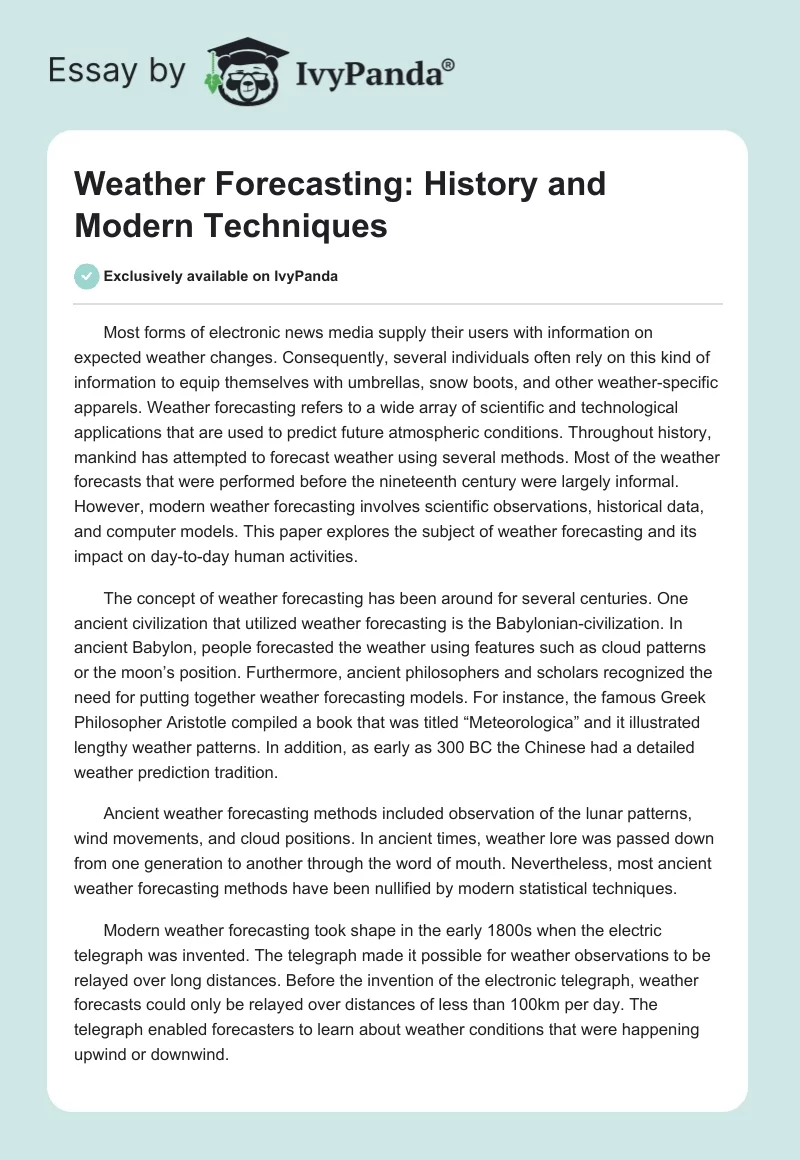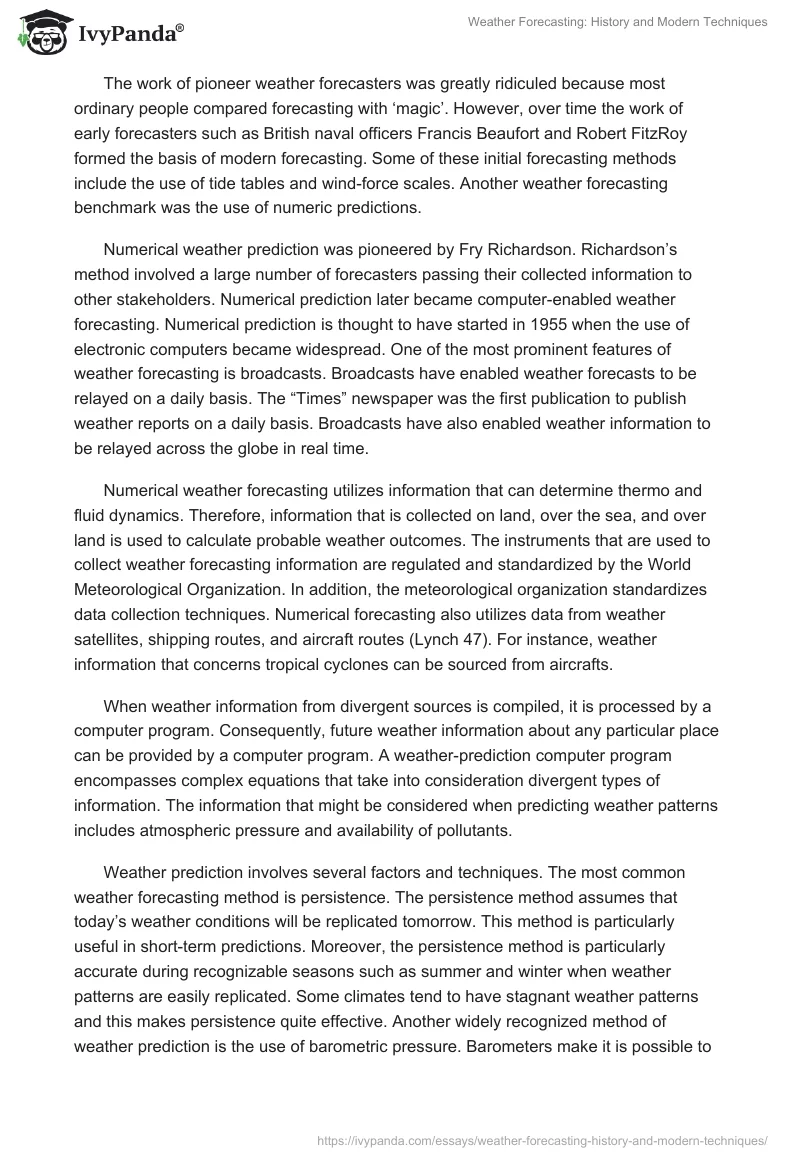Most forms of electronic news media supply their users with information on expected weather changes. Consequently, several individuals often rely on this kind of information to equip themselves with umbrellas, snow boots, and other weather-specific apparels. Weather forecasting refers to a wide array of scientific and technological applications that are used to predict future atmospheric conditions. Throughout history, mankind has attempted to forecast weather using several methods. Most of the weather forecasts that were performed before the nineteenth century were largely informal. However, modern weather forecasting involves scientific observations, historical data, and computer models. This paper explores the subject of weather forecasting and its impact on day-to-day human activities.
The concept of weather forecasting has been around for several centuries. One ancient civilization that utilized weather forecasting is the Babylonian-civilization. In ancient Babylon, people forecasted the weather using features such as cloud patterns or the moon’s position. Furthermore, ancient philosophers and scholars recognized the need for putting together weather forecasting models. For instance, the famous Greek Philosopher Aristotle compiled a book that was titled “Meteorologica” and it illustrated lengthy weather patterns. In addition, as early as 300 BC the Chinese had a detailed weather prediction tradition.
Ancient weather forecasting methods included observation of the lunar patterns, wind movements, and cloud positions. In ancient times, weather lore was passed down from one generation to another through the word of mouth. Nevertheless, most ancient weather forecasting methods have been nullified by modern statistical techniques.
Modern weather forecasting took shape in the early 1800s when the electric telegraph was invented. The telegraph made it possible for weather observations to be relayed over long distances. Before the invention of the electronic telegraph, weather forecasts could only be relayed over distances of less than 100km per day. The telegraph enabled forecasters to learn about weather conditions that were happening upwind or downwind.
The work of pioneer weather forecasters was greatly ridiculed because most ordinary people compared forecasting with ‘magic’. However, over time the work of early forecasters such as British naval officers Francis Beaufort and Robert FitzRoy formed the basis of modern forecasting. Some of these initial forecasting methods include the use of tide tables and wind-force scales. Another weather forecasting benchmark was the use of numeric predictions.
Numerical weather prediction was pioneered by Fry Richardson. Richardson’s method involved a large number of forecasters passing their collected information to other stakeholders. Numerical prediction later became computer-enabled weather forecasting. Numerical prediction is thought to have started in 1955 when the use of electronic computers became widespread. One of the most prominent features of weather forecasting is broadcasts. Broadcasts have enabled weather forecasts to be relayed on a daily basis. The “Times” newspaper was the first publication to publish weather reports on a daily basis. Broadcasts have also enabled weather information to be relayed across the globe in real time.
Numerical weather forecasting utilizes information that can determine thermo and fluid dynamics. Therefore, information that is collected on land, over the sea, and over land is used to calculate probable weather outcomes. The instruments that are used to collect weather forecasting information are regulated and standardized by the World Meteorological Organization. In addition, the meteorological organization standardizes data collection techniques. Numerical forecasting also utilizes data from weather satellites, shipping routes, and aircraft routes (Lynch 47). For instance, weather information that concerns tropical cyclones can be sourced from aircrafts.
When weather information from divergent sources is compiled, it is processed by a computer program. Consequently, future weather information about any particular place can be provided by a computer program. A weather-prediction computer program encompasses complex equations that take into consideration divergent types of information. The information that might be considered when predicting weather patterns includes atmospheric pressure and availability of pollutants.
Weather prediction involves several factors and techniques. The most common weather forecasting method is persistence. The persistence method assumes that today’s weather conditions will be replicated tomorrow. This method is particularly useful in short-term predictions. Moreover, the persistence method is particularly accurate during recognizable seasons such as summer and winter when weather patterns are easily replicated. Some climates tend to have stagnant weather patterns and this makes persistence quite effective. Another widely recognized method of weather prediction is the use of barometric pressure. Barometers make it is possible to measure changes in atmospheric pressure. When significant changes in barometric pressure are noticed, it is likely that the weather conditions will also change.
For instance, declines in atmospheric pressure are usually associated with high chances of rainfall. On the other hand, increases in pressure signify clearer weather conditions such as sunshine. In tropical regions, the sky is the best weather forecasting utility. Just by looking at the sky, individuals residing in mountainous regions can be able to predict future weather. Sky-observation provides a wide array of other possible weather conditions. For instance, cloudy skies indicate that there might be high chances of rainfall. On the other hand, clear skies suggest that there might not be any rainfall in the near future.
During the night, clear skies, warm temperatures, and a clearly visible moon indicate that there might be high chances of rainfall. Sky observation might also be associated with wind patterns because strong winds eliminate the possibility of clouds gathering. Even in the advent of sophisticated weather prediction methods, sky observation is widely used by populations around the world (Gneiting and Raftery 248).
Weather forecasting also refers to the practice of predicting how the atmospheric conditions might change within the next few hours. This form of weather forecast is also known as ‘nowcasting’. There are several aspects of weather forecasting that might not be relevant to a computerized-prediction model. For example, features of rainfall such as thunderstorms and rain intensity can be accurately predicted using nowcasting. Another traditional but reliable weather forecasting technique is the use of analog methods. In the analog method, forecasters try to remember past weather patterns in the hope that they will be mimicked in the future.
However, this method is often disputed by the fact that even though future weather patterns might be similar it is almost impossible for them to be identical (Maqsood, Khan and Abraham 115). For instance, the weather patterns that precede the El Niño phenomenon are replicated several times. However, the actual El Niño only occurs very few times.
Although weather forecasting is a routine activity in modern times, it is quite significant to mankind. Weather forecasters aid in the provision of severe weather advisories and warnings. For instance, most countries have an active national weather service that warns citizens about impending severe weather conditions. In addition, activities such as air traffic control, agriculture, marine transport, and forestry depend on accurate weather predictions. Most military activities such as naval and air force operations depend on weather forecasting.
Works Cited
Gneiting, Tilmann, and Adrian E. Raftery. “Weather forecasting with ensemble methods.” Science 310.574 (2005): 248-249. Print.
Lynch, Peter. The emergence of numerical weather prediction: Richardson’s dream, New York, NY: Cambridge University Press, 2006. Print.
Maqsood, Imran, Muhammad Khan and Ajith Abraham. “An ensemble of neural networks for weather forecasting.” Neural Computing & Applications 13.2 (2004): 112-122. Print.


